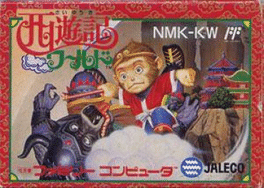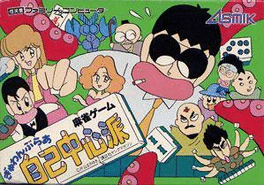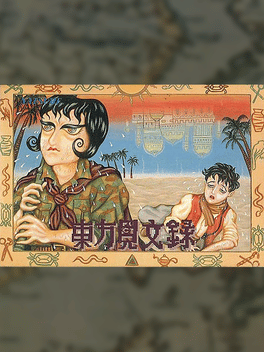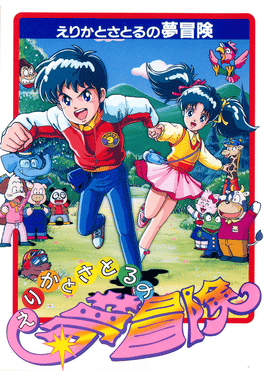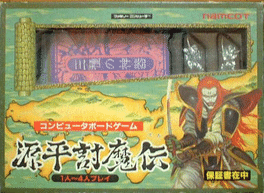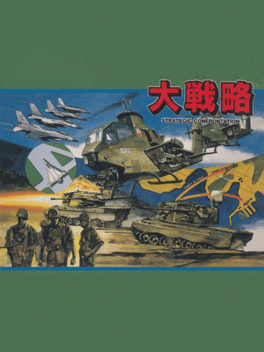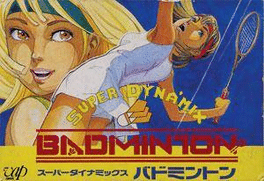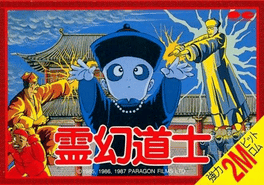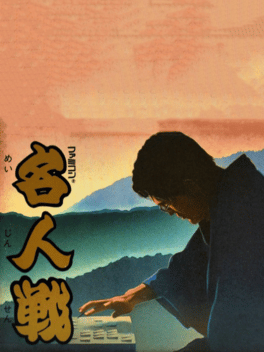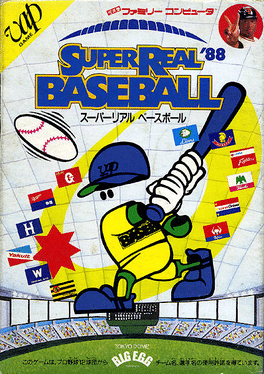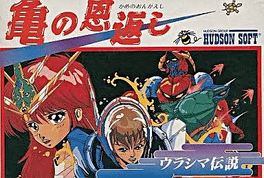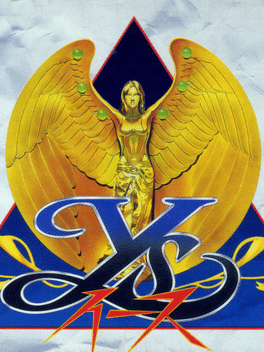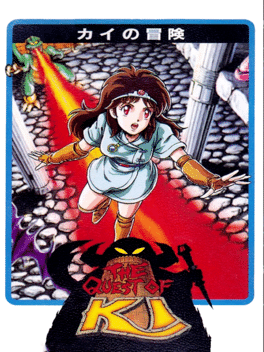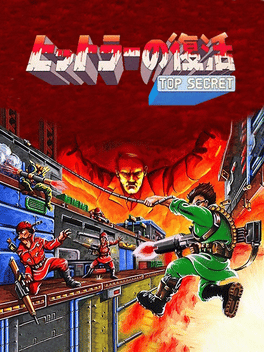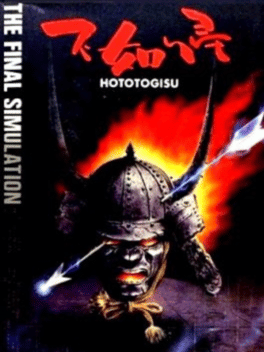New Family Computer Games - Page 35
-
Saiyuuki World
1988
Saiyuuki World
1988
Saiyuuki World is an action game based on Wonder Boy in Monster Land but modified with content from the classic Chinese novel Journey to the West. -
Gambler Jiko Chuushinha
1988
A Mahjong game based on a manga license, published by Asmik for the NES and MSX in Japan only. -
Touhou Kenbun Roku
1988
Touhou Kenbun Roku
1988
A sci-fi/comedy NES adventure game developed and published by Natsume in Japan only. Touhou Kenbun Roku ("The Travels of Marco Polo") is an adventure game that uses the then-ubiquitous NES adventure game system of having a series of menu commands with which to interact with the world. As a text-heavy Japanese adventure game, some fluency with the language is required in order to play it. The game depicts a troublemaker sent from the future back to 1275, when Marco Polo was in the midst of his explorations. -
United State Presidental Race
1988
America Daitoryo Senkyo: United State Presidental Race is a Strategy game which was released in Japan in 1988. -
Erika to Satoru no Yume Bouken
1988
Erika to Satoru no Yume Bouken is a 1988 Japan-exclusive adventure video game for the Famicom. It is a fairytale-inspired menu-driven adventure game. Players use the menu commands to interact with the world: moving around, looking around, picking up objects, talking to people, etc. The setting of this game is 20th century Japan. In a novel twist, the two characters of Erika and Satoru (who are depicted as twin schoolchildren) are independently playable - either a single player switches between the two, or a second player takes over the second twin. Both characters need to be in the same region to converse with NPCs, but are otherwise free to explore the map autonomously. Two-player adventure games are very rare; even in Japan. However, only one person can partake in the animal quiz portion. Failing the quiz will force the player(s) to start from the beginning. An odd bit of infamy related to this game is a secret developer's message that can be found if the player inputs a list of button presses after waiting som -
Computer Board Game: Genpei Touma-den
1988
In October 1988, Namco released a version of Genpei Tōma Den for the Family Computer titled Genpei Tōma Den Computer Board Game. Packaged with a physical cloth game board, cards, and metallic player figures molded after Kagekiyo, it takes the form of a virtual board game where players compete against each other to conqueror all of Japan. Where as Genpei Tōma Den was a side-scrolling action game, Computer Board Game is instead a role-playing game, where players engage in battles with enemies and purchase items and equipment from stores. The idea for the game came from Namco designer Yuichiro Shinozaki wanting to further expand on the lore and world of the original game. -
Daisenryaku
1988
Daisenryaku
1988
Daisenryaku is a Strategy game, developed by Quest and published by Bothtec, which was released in Japan in 1988. -
Super Dyna'mix Badminton
1988
Super Dyna'mix Badminton is the first game for the Famicom to cover the sport of badminton. It was created by the developer/publisher team Pax Softnica and Vap Inc., previously behind Super Real Baseball '88. The game is depicted by a side-view, more commonly associated with volleyball video games than tennis video games, the latter favoring a viewpoint from behind one of the competitors. This comparison is also true for the sport of badminton itself, which has a similar focus on performing hard-to-counter spike attacks close to the net in order to score points. Because of the irregular flight path of a shuttlecock, the player needs to focus more on its shadow than the projectile itself in order to play effectively. Though the game has options for both male and female characters every character sprite is the same androgynous black-haired person. The only real change is that games are shorter for female competitors as they would be in real life. The game also allows for four different "coats" on the main menu - as -
Donald Duck
1988
-
Reigen Doushi
1988
Reigen Doushi
1988
Reigen Doushi is a beat 'em up video game released for the Nintendo Entertainment System in 1988 in Japan. It is based on the 1985 film, Mr. Vampire (Reigen Doushi being the Japanese title of the film). -
Famicom Meijinsen
1988
Famicom Meijinsen
1988
Famicom Meijinsen is a Miscellaneous game, developed by Alpha Denshi and published by SNK, which was released in Japan in 1988. -
Super Real Baseball '88
1988
Super Real Baseball '88 is a baseball game developed by Pax Softonica for the Famicom and published in Japan by Vap in 1988. After Namco excited the market for baseball games with the release of Pro Yakyuu Family Stadium, many other companies attempted to meet the demand for more baseball games. This title differentiated itself from other baseball games by obtaining permission from the Professional Baseball Organization of Japan to use the official names of the 12 Japanese baseball teams and their players. This was a groundbreaking feature at the time. It was also the first game to depict an existing stadium with it's actual name, the Tokyo Dome, which had just opened shortly before the game's release. Outfielder and first baseman Warren Cromartie, formerly with the Montreal Expos, and playing for the Yomiuri Giants at the time, was chosen to help promote the game. To further distinguish the game, the developers chose to use a more realistic approach when depicting the players on the field, as opposed to the more -
Kame no Ongaeshi: Urashima Densetsu
1988
Kame no Ongaeshi: Urashima Densetsu is a 1988 video game published by Hudson Soft for the Nintendo Entertainment System. The game was released in Japan on August 26, 1988, and saw a North American release sometime in April 1990. The game was never released in Europe and the game is not playable on PAL consoles. The story takes place in the post-apocalyptic year of 2777, after Earth has been devastated by nuclear war and natural disasters, with the island nation of Xexyz now being threatened by alien robots. The Japanese Famicom version is based on the tales of Urashima Tarō, features cutscenes throughout the game, a choice of three endings and has minor graphical differences in some of the NPCs. -
Ys
1988
Ys
1988
In this game, the player takes the role of Adol (Aron in the English-language Sega Master System version) Christin, a red-haired adventurer and expert swordsman. One day he encounters a fortune teller who sends him on a quest to find information about the six books of Ys. It appears that there was once an ancient land called Ys, whose secret was sealed in those six books. Before long Adol learns that the six books were all stolen by the evil wizard Dark Fact (Dulk Dekt in the Sega Master System version, Malificus in the English-language computer versions). It is Adol's task to defeat the villain and discover the secret of Ys! -
The Quest of Ki
1988
The Quest of Ki
1988
The Quest of Ki is a 1988 video game developed by Game Studio and published by Namco for the Family Computer. It is the third game in Babylonian Castle Saga series which started with the 1984 arcade game, The Tower of Druaga. The story of The Quest of Ki is actually a prequel to the original Tower of Druaga. It occurs shortly after the demon Druaga has stolen the Blue Crystal Rod and taken it to his tower. The goddess Ishtar sends the priestess Ki to the tower in order to retrieve it. The game then follows her doomed quest to the top of the tower, and leads directly into the story of the original game. The game is a side-scrolling platformer with one hundred levels. In each level, the player's goal is to pick up a key and open the door leading to the next area. Various enemies, including slimes, ghosts, and wizards, appear on each floor, and any contact with them results in death. Ki has no weapons, and thus can not damage or defeat any of the enemies. Her only abilities are to dash and jump. As long as the play -
Hitler no Fukkatsu: Top Secret
1988
The Nazis are back - they have survived the war and, led by their supreme leader Weizmann, they have now come up with the most evil and horrific plan in history! Hitler, the man who the allies thought was dead, has been revived and his fractions of hell are about to take over the world once again. The allies decide to send one of their best men, Super Joe, to counter the threat - but he is soon captured and Radd Spencer is dispatched to rescue him and complete the primary mission. -
Hototogisu
1988
Hototogisu
1988
A Sengoku-era war simulation game developed by Tamtex for the Famicom in 1988. It was never released outside of Japan. -
Jarinko Chie: Bakudan Musume no Shiawase Sagashi
1988
"Jarinko Chie: Bakudan Musume no Shiawase Sagashi" is a graphical text-adventure game. It is a game based on the Jarinko Chie anime and manga about a dependable girl who struggles to help her troublesome father run a small tavern in Osaka. Unbeknownst to her dad, she occasionally visits her mother who left him not too long ago. She plans on trying to reunite them, but not until her father gets a job. Though it is largely text driven, there are moments where the player must play a mini-game in order to advance to the next chapter of the story. -
Dragon Ball: Daimaou Fukkatsu
1988
Dragon Ball: Daimaou Fukkatsu is a role playing video game released only in Japan by Bandai on August 12, 1988. It is the second Dragon Ball video game released for the Nintendo Famicom. Daimaō Fukkatsu is the first role playing game based on the Dragon Ball series. Its gameplay was reused in the Goku-den video game series. Daimaou Fukkatsu is also one of the games included in the game compilation J Legend Retsuden for Nintendo 3DS. -
Soccer League: Winner's Cup
1988
Soccer League - Winner's Cup is a soccer game developed by SAS Sakata for the Famicom, and published by Data East in 1988. During game play, field scrolls horizontally across the screen. Players select one of eight international teams and attempt to win the World Cup. The teams that the player can select include: Japan, Germany, Brazil, France, South Korea, England, Argentina, and the USA. Players may choose to play solo against the computer, or compete head to head with another player. Although the game was never released outside of Japan, most of the options are written in English.
